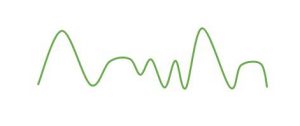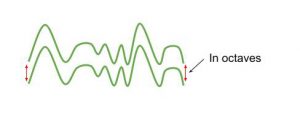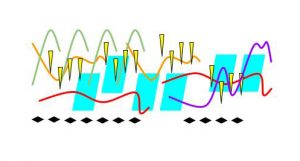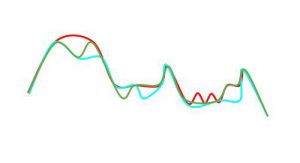1 Fundamentals
Justin R. Hunter
This fundamental material established core vocabulary and concepts that will be used through the course. These six groups below will help students be able to understand how music works, breaking the music down in the sonic elements. Each group—Timbre, Dynamics, Pitch, Melody & Harmony, Time & Form, and Texture.
-
TIMBRE
- TIMBRE – the way a sound sounds to distinguish one sound from another.
The word timbre (pronounced: tam-ber) can be highly subjective. Timbre is the way something sounds, e.g., the singer sounds nasal. Synonyms for timbre often include “tone color,” “sound quality,” or “character of sound.” This concept is not meant to be a judgement statement, but a description that helps to identify similarities and differences between sounds and musics.
Imagine trying to describe two instruments of the same type, a guitar and a ‘ukulele, for example. Describing the way these two instruments sound similar and different helps to distinguish them sonically, see Examples 1.1 (guitar) and 1.2 (‘ukulele) below.
Describing two or more unrelated instruments/sounds can be easier. However, if the instruments are playing the same, it can still be difficult to distinguish them, see Example 1.3 below.
The examples below demonstrate different types of timbral descriptions, but there are numerous descriptors to use. Listen to each example and describe what you hear. What sounds similar between Examples 1.1 and 1.2? What sounds are different between the three instruments in Example 1.3?
Other ways to describe timbre are to point out features used by the voices/instruments. The singer in Example 1.4 is using a strong vibrato but the melody in Example 1.3 uses a straight tone. Chinese jingju is known for its nasal qualities (Example 1.5) while the singer in Example 1.4 has a full round sound. There are numerous descriptor words that will be addressed in this class, some may include: rough/smooth, falsetto/chest voice, airy/full, etc.
- VIBRATO – a pitch fluctuation added to a sustained note for a richer sound
- STRAIGHT TONE – lack of pitch fluctuation on a sustained note
- NASAL – closed off timbre that sounds like it is produced from the nasal cavity
- ROUND – open timbre with full resonance
Examples:
Example 1.1
| Title: | “O’Carolan: Si Bheag, Si Mhor” (“Small Fairy Mound, Big Fair Mound” attributed to Turlough O’Carolan) |
| Artist: | Jack Isidore |
| Link: | https://www.youtube.com/watch?v=W9-RkcOKmJk |
| Year: | 2015 |
| Language: | n/a |
| Origin: | Ireland |
Example 1.2
| Title: | “Hawaiian Waltz” |
| Artist: | Kamiki Ukulele |
| Link: | https://www.youtube.com/watch?v=Sy9xl2521qc |
| Year: | 2014 |
| Language: | n/a |
| Origin: | Hawaii (United States) |
Example 1.3
| Title: | “Etenraku” |
| Artist: | Tokyo Gagaku |
| Link: | https://www.youtube.com/watch?v=0T1pyZZiBO0 |
| Year: | 2014 |
| Language: | n/a |
| Origin: | Japan |
| Description: | Each instrument is playing the same melody so distinguishing each instrument’s sound is important to understand how the music is working. The differences between the instruments, the way they sound, is the timbre. |
| 0:06-0:18 | Solo flute (ryuteki) part establishing the melody |
| 0:19 | Mouth organs (sho) play note cluster of melodic line |
| 0:21 | Ensemble joins flute and organs in playing melody, each line has their own established embellishments but each is playing the same melody. |
Example 1.4
| Title: | “La Charreada” |
| Artist: | Sandra Gonzalez with Mariachi Alas |
| Link: | https://www.youtube.com/watch?v=jQy2MvTr8Ek |
| Year: | 2016 |
| Language: | Spanish |
| Origin: | Mexico |
| Description: | |
| 0:00-0:23 | Instrumental and vocal intro |
| 0:24-0:28 | Vocal vibrato on sustained opening note |
Example 1.5
| Title: | “Dedengdian” |
| Artist: | Shengsu Li |
| Link: | https://www.youtube.com/watch?v=mN9iXlfxpxI |
| Year: | 2008 |
| Language: | Mandarian Chinese |
| Origin: | China |
-
DYNAMICS
- DYNAMICS – relative loudness/softness of sound; volume
While this element seems easier than others, the real key is to pinpoint which sounds are louder, and softer, than others in music. This will help describe that sound more clearly. Many students with previous music experience will know standard musical terms, often from Italian, French, and German (e.g., crescendo, pianissimo, forte, etc.). While these words are useful, for the purposes of this class, it is easier to avoid such terms. Describing music as having an increase in volume from a quiet section to a louder section is just as effective.
Example 2.1
| Title: | “Get Up, Stand Up” |
| Artist: | Bob Marley and the Wailers |
| Link: | https://www.youtube.com/watch?v=RhJ0q7X3DLM |
| Year: | 1980 |
| Language: | English |
| Origin: | Jamaica |
| Description: | The music begins with an instrumental intro. When Bob Marley begins the lyrics, “Get Up, Stand Up,” the instruments become less audible due to Marley’s voice being amplified louder. Also, the background singers are not as loud as Marley. |
-
PITCH
- PITCH – frequency of a sound; highness or lowness of a sound
For this text, “pitch” is used as both a specific term, as defined above, and a grouping of concepts that encompass many ideas related to that specific term. Two common synonyms for “pitch” include tone and note, all may be used throughout the text.
Music is made of many sounds. Pitches are distinguished from other sounds as they have measurable frequencies. Each pitch has a specific wavelength, known as a frequency and measured in hertz. This measurement is, of course, culturally derived and not universally recognized around the world or throughout history.
Many concepts are brought together in the grouped idea of “pitch.”
- Fundamental – the “base note” that the melody is based (synonym: tonic)
- Interval – the distance between two pitches
- Range – the distance between the highest pitch and lowest pitch in a melody
- Octave – a doubling of a frequency but the same pitch set
- Scale/Mode – culturally prescribed arrangements of intervals and pitches
Example 3.1
| Title: | “I’ll Fly Away” |
| Artist: | David Durrence |
| Link: | https://www.youtube.com/watch?v=rZWZ7KpB5Zg |
| Year: | 2011 |
| Language: | n/a |
| Origin: | United States |
| Description: | This example uses a fundamental tone that is continuously played on the lower string as the melody is played on a higher string as the performer moves his fingers on the board. The pitch range is somewhat narrow with the use of only 4-6 notes in a medium to low range of the instrument. |
-
MELODY & HARMONY
- MELODY – a sequence of pitches perceived as a unit (synonym: tune)
Like pitch, “melody” is both a specific term, as defined above, and a grouping of related concepts. The melody is the main line of interest, the tune you are left with after hearing a piece of music. Think of pop music and the tunes that get stuck in your head. It is the melody that stays with you, not the background sounds and rhythms.
Melodies can be described with many characteristics from the way the melody line moves to the way other sounds harmonize with or support the melody.
- Conjunct motion – stepwise (small intervals) melodic motion
- Disjunct motion – melodic motion by leaps (large intervals)
- Ornaments – elaborations on the set melody
- Phrase – sections of the melody and music, often a “breath’s worth” of music
Example 4.1
| Title: | “Aloha Oe” |
| Artist: | Israel “IZ” Kamakawiwo‘ole, Henry Kapono, and Cyril Pahinui |
| Link: | https://www.youtube.com/watch?v=zXOzNiKceps |
| Year: | 1991 |
| Language: | Hawaiian/English |
| Origin: | Hawaii |
| Description: | This is an example of stepwise motion. There are few jumps in the melody even though the range is large. |
Example 4.2
| Title: | Ornamentation in Indian Music |
| Artist: | Anuja Kamat |
| Link: | https://www.youtube.com/watch?v=9t4WcumdnR0&t=336s |
| Year: | 2014 |
| Language: | English |
| Origin: | India |
| Description: | This video goes through several types of ornamentation in Indian music. Each example includes a non-ornamented section followed by specific ornamentations. |
- HARMONY – perception of the way musical layers sound together
Harmony is always culturally and time based. Like timbre, harmony can be quite subjective. However, two descriptions of harmony are useful in understanding the music introduced in this class.
- Consonant harmony (consonance) – relaxed, open sounding harmony
- Dissonant harmony (dissonance) – tense, closed sounding harmony
Example 4.3
| Title: | “Jarabi” |
| Artist: | Sona Jobarteh |
| Link: | https://www.youtube.com/watch?v=oToZfPGMMBY |
| Year: | 2011 |
| Language: | n/a |
| Origin: | West Africa |
| Description: | This piece uses consonant harmony that in layman’s terms is often referred to as “happy” sounding due to the ease in which it is heard. Often, this music sounds “in tune,” but that is culturally dependent. |
Example 4.4
| Title: | “Song of the Spring Cicada” |
| Artist: | Dong People |
| Link: | https://www.youtube.com/watch?v=D1XiJ27MciU |
| Year: | 2009 |
| Language: | Kam |
| Origin: | China |
| Description: | This highly layered music uses intentionally narrow intervals to create a dissonant sound. While it may seem “out of tune,” this is a culturally-based assumption. |
-
TIME & FORM
Time and Form are somewhat dependent on each other. Time is of an understanding of the sequential framework of how the music is temporally organized. Form is an understanding of sections of music, which often can be noticed through changes in time.
- Pulse – the pulsation of music, “the beat”
- Rhythm – a series of pulsations understood as a unit
- Tempo – the rate of speed of the music
- Meter – temporal description of the organization of the pulse
- Accent – emphasis on a pulse
- Syncopation – destabilizing beat created with accents
Within the idea of meter, which is an understanding of the organization of the pulse, there are fixed and free meters. To determine the meter of music, first find the pulse.
Music with a free meter does not have a discernible and repeatable pattern in the pulse; the listener would not be able to find a regular beat, for instance listen to Example 5.1.
Example 5.1
| Title: | “Honshirabe” |
| Artist: | Bronwyn Kirkpatrick |
| Link: | https://www.youtube.com/watch?v=mkNvHSPbiTM |
| Year: | 2012 |
| Language: | n/a |
| Origin: | Japan |
| Description: | The music lacks a formal pulse. No only is the tempo slow, but the rhythms are not easily understood as units together, but rather as independent thoughts. |
Music with a fixed meter has a clearly found and repeatable pattern in the pulse. Most music follows this form of meter. As you listen to Examples 5.2 and 5.3, you will be able to find the pulse easily. Tap your foot as you listen.
Fixed meters have two basic categories: duple meter and triple meter. These meters have clearly defined pulsation and are organized in repeatable groupings of time. Duple meters are organized in divisions of 2 that alternate strong and weak beats. One of the most common duple meters in Western popular music and art music is a 4 beat meter where beats 1 and 3 are strong. Triple meters are organized in divisions of 3 with one strong beat (beat 1) followed by two weaker ones (beats 2 and 3).
There are also complex meters that combine duple and triple organization, but the purposes of this class, these complex meters are rare and will not be discussed in detail.
Example 5.2: Duple meter
| Title: | “Didn’t It Rain” |
| Artist: | Sister Rosetta Tharpe |
| Link: | https://www.youtube.com/watch?v=3NFywQdeKSo |
| Year: | 1964 |
| Language: | English |
| Origin: | United States |
| Description: | Strong duple meter with accents on beats 2 and 4 emphasising the repetitive nature of duple structure. |
Example 5.3: Triple meter
| Title: | “El Son de la Negra” |
| Artist: | Mariachi Vargas de Tecalitlan |
| Link: | https://www.youtube.com/watch?v=XTwmQ-R7Joc |
| Year: | 2018 |
| Language: | Spanish |
| Origin: | Mexico |
| Description: | As the music begins at around 0:18, the tempo increases locking into a strong triple meter. This meter is commonly heard in waltzes where beat 1 is weighted with beats 2 & 3 sounding a light “oom pas.” |
-
TEXTURE
Most of the music you listen to has layers of different sounds, sometimes that is easier to hear than others. Think about a pop song and how the main voice stands out from the background sounds. In simple terms, you are hearing multiple layers of sound, this is texture in music.
Texture refers to the number of parts and the roles the parts play. There are four main types of texture: monophonic, homophonic, polyphonic, and heterophonic.
MONOPHONIC TEXTURE includes just a single melody line (Figure 5.1) or a group of instruments/voices performing the same line in octaves (Figure 5/2). Example 5.1 below has a single layer of sound, first performed by a flute, then singing, then the flute again.
Figure 6.1: Single line of sound

Figure 6.2: Same line layered in octaves

Example 6.1: Monophonic texture
| Title: | “Ch’aska: Song for the Stars” |
| Artist: | Don Pasqual Apaza Flores |
| Link: | https://www.youtube.com/watch?v=cXgNf2ztAtA |
| Year: | 2015 |
| Language: | Quechua |
| Origin: | Peru |
| Description: | |
| 0:00-0:38 | Single layer of flute playing |
| 0:38-1:13 | Single layer of singing |
| 1:13-1:37 | Single layer of flute playing |
HOMOPHONIC TEXTURE includes two or more layers of sound, typically with one line sounding the melody. Again, think about pop music. The lead singer’s voice is the most important line, the backing vocals, instruments, and drum beats are secondary as they accompany the main melody coming from the singer. The second layer can be complex with textures of its own, but it remains a secondary layer to the main voice.
Figure 6.3: Melody in green with harmony, drums, and other sounds in red, blue, and black.

Example 6.2: Homophonic texture
| Title: | “Little Birdie” |
| Artist: | The Kossoy Sisters |
| Link: | https://www.youtube.com/watch?v=nl_cTy-euj4 |
| Year: | 2013 |
| Language: | English |
| Origin: | United States |
| Description: | |
| 0:15-0:35 | Instrumental intro |
| 0:35-0:57 | Chorus: Singers sing in tight harmony with banjo and guitar becoming secondary to the vocal line (main melody) |
| 0:57-1:18 | Verse: Voice solo with banjo and guitar playing secondary line |
| 1:18-1:38 | Chorus: Singers sing in harmony with banjo and guitar in secondary line |
| 1:39-2:21 | Verse: Voice solo with banjo and guitar playing secondary line |
| 2:22-2:42 | Chorus: Singers sing in harmony with banjo and guitar in secondary line |
| 2:42-3:01 | Instrumental |
| 3:01-3:22 | Verse: Voice solo with banjo and guitar playing secondary line |
| 3:22-3:45 | Chorus: Singers sing in harmony with banjo and guitar in secondary line |
POLYPHONIC TEXTURE includes multiple lines that use contrary motion with interwoven layers of sound, resulting in two or more simultaneous independent melodies. This texture is commonly found in many choir and band compositions. There are multiple melody lines and when they are put together the multiple sounds complete a bigger picture.
Figure 6.4: No one melody throughout, each instrument group/voice build their individual part to create a more complex sound.

Example 6.3: Polyphonic texture
| Title: | “Shemokmedura” |
| Artist: | Erisioni |
| Link: | https://www.youtube.com/watch?time_continue=49&v=KHXpT8WKO5o&feature=emb_logo |
| Year: | 2013 |
| Language: | Georgian |
| Origin: | Georgia |
| Description: | |
| 0:00-0:08 | 1st solo part |
| 0:08-0:17 | Harmonic layers added to solo part |
| 0:17-0:23 | 2nd solo part |
| 0:23-0:32 | Harmonic layers added to solo part with contrasting motion |
| 0:32 | 3rd solo part with harmonic layers |
| 0:42 | Yodel added in contrast to melody |
| 0:50-1: | Set of variations begin with more complex layering and more singers added |
HETEROPHONIC TEXTURE includes at least two performers playing simultaneous variations of the same melody. Each performer/section embellished the melody on their own but play in unison for the majority of the music. The melodic line will move together in time and melodic shape without contrasting motion.
Figure 6.5: Single melody, duplicated by different instruments each with their own embellishment of the melody. Each line follows the basic shape of the melody but has slight variation from the other lines.

Example 6.4: Heterophonic texture
| Title: | “Etenraku” |
| Artist: | Tokyo Gagaku |
| Link: | https://www.youtube.com/watch?v=0T1pyZZiBO0 |
| Year: | 2014 |
| Language: | n/a |
| Origin: | Japan |
| Description: | |
| 0:06-0:18 | Solo flute (ryuteki) part establishing the melody |
| 0:19 | Mouth organs (sho) play note cluster of melodic line |
| 0:21 | Ensemble joins flute and organs in playing melody, each line has their own established embellishments but each is playing the same melody. |
the way a sound sounds to distinguish one sound from another
a pitch fluctuation added to a sustained note for a richer sound
lack of pitch fluctuation on a sustained note
closed off timbre that sounds like it is produced from the nasal cavity
open timbre with full resonance
relative loudness/softness of sound; volume
frequency of a sound; highness or lowness of a sound
the “base note” that the melody is based (synonym: tonic)
the distance between two pitches
the distance between the highest pitch and lowest pitch in a melody
a doubling of a frequency but the same pitch set
culturally prescribed arrangements of intervals and pitches
a sequence of pitches perceived as a unit (synonym: tune)
stepwise (small intervals) melodic motion
melodic motion by leaps (large intervals)
elaborations on the set melody
sections of the melody and music, often a “breath’s worth” of music
perception of the way musical layers sound together
relaxed, open sounding harmony
tense, closed sounding harmony
the pulsation of music, “the beat”
a series of pulsations understood as a unit
the rate of speed of the music
temporal description of the organization of the pulse
emphasis on a pulse
destabilizing beat created with accents
Main melodic line with harmonic support; accompaniment may be simple or complex
Multiple lines sounded together to create a more complete sound
Simultaneous variation of a single melodic line; “same, but different”

